#extracellular fluid
Video
Thick and Fast
Cells in the body never operate in isolation; they are influenced by everything in their local environment, from neighbouring cells to the extracellular fluid (ECF) around them. One key property of the ECF is its viscosity, thickness or stickiness – picture the difference between water and honey. Rather counterintuitively, some cells that attach to surfaces travel faster through thicker solutions, as demonstrated by this breast cancer cell. Membrane protrusions, making ruffles at the edge of the cell, probe its surroundings, and act as viscosity sensors: when thickener is added to the culture medium, the ruffles disappear, the cell spreads out, becomes flatter and moves faster (in this 3D rendering, cooler colours indicate taller sections). Higher viscosity can be associated with several medical conditions, whether in the ECF around cancer cells, or mucus in lungs affected by cystic fibrosis, so understanding how cells respond could be relevant to disease progression and treatment.
Written by Emmanuelle Briolat
Video from work by Matthew Pittman and colleagues
Department of Mechanical Engineering, Johns Hopkins University, Baltimore, MD, USA
Video copyright held by the original authors
Research published in Nature Physics, July 2022
You can also follow BPoD on Instagram, Twitter and Facebook
#science#biomedicine#Cancer#tumour cells#cystic fibrosis#viscosity#extracellular fluid#breast cancer#cancer cell#cell membrane#immunofluorescence
15 notes
·
View notes
Text
Serum/plasma sodium is about what fluid is doing!
You have intracellular and extracellular space (functionally, there are TWO compartments, but you have intravascular/plasma space and interstitial space, in addition to intracellular environment. There's normally around 28L of intraCELLULAR fluid.)
Adding normal saline is like giving your body "its own water," meaning it won't change your sodium concentration. Administering normal saline corrects hypovolemic hypernatremia (meaning fluid VOLUME is low, and sodium concentration appears very high. Giving more fluid will reduce serum/plasma sodium back to normal).

Sodium is a polar molecule and moves freely between intravascular and interstitial space. Wherever the sodium is highly concentrated, that is where water will go. Water shifts into interstitial fluid space when you have edema (AKA third spacing)
#dietetics#fluid#volume#hypovolemic#hypermatremia#sodium#intravascular#intracellular#interstitial#extracellular
0 notes
Text
Electrolytes and why they're important especially when water f4st!ng:
Electrolytes are electrically charged minerals, such as sodium, potassium, calcium, magnesium, chloride, bicarbonate, and phosphate. They are involved in various physiological processes.
During a water f4st, the body can lose electrolytes through various means, such as urine, sweat, and even through breathing.
Without sufficient intake of electrolytes, the body may experience imbalances that can lead to various health issues including:
muscle cramps, dizziness, weakness, irregular heartbeats, and in severe cases, even life-threatening conditions such as de4th.
Here's a breakdown of each electrolyte and its role in the body:
Sodium (Na+):
Role: Sodium is the primary extracellular cation (positively charged ion) and plays a vital role in maintaining fluid balance and blood pressure. It is essential for nerve impulse transmission and muscle function.
Source: Commonly found in table salt (sodium chloride) and many processed foods.
Potassium (K+):
Role: Potassium is the primary intracellular cation. It helps regulate fluid balance, nerve impulses, muscle contractions (including the heart), and maintains proper cellular function.
Source: Found in various fruits and vegetables, such as bananas, oranges, potatoes, and spinach.
Calcium (Ca2+):
Role: Calcium is essential for maintaining strong bones and teeth. It also plays a key role in muscle contractions, nerve transmission, blood clotting, and cell signaling.
Source: Dairy products, leafy greens, nuts, and fortified non-dairy milk.
Magnesium (Mg2+):
Role: Magnesium is involved in hundreds of enzymatic reactions in the body, including energy production, protein synthesis, muscle and nerve function, and maintaining healthy bones.
Source: Found in nuts, seeds, whole grains, leafy greens, and legumes.
Chloride (Cl-):
Role: Chloride is the major extracellular anion (negatively charged ion) and works closely with sodium to help maintain fluid balance and osmotic pressure in cells.
Source: Commonly found in table salt (sodium chloride) and many processed foods.
Bicarbonate (HCO3-):
Role: Bicarbonate is involved in regulating the body's acid-base balance (pH level) and is a crucial component of the bicarbonate buffering system.
Source: The body produces bicarbonate as part of normal metabolic processes.
Phosphate (HPO42-):
Role: Phosphate is essential for bone and teeth mineralization, energy production (adenosine triphosphate, ATP), and serves as a component of DNA and RNA.
Source: Found in various foods, including meat, dairy products, nuts, and whole grains.
To prevent these complications and support the body during a water f4st, it is crucial to supplement with electrolytes.
Many people who practice prolonged water f4st!ng or intermittent f4st!ng find it helpful to take electrolyte supplements or consume electrolyte-rich drinks to ensure they maintain proper mineral balance throughout the f4!sting period. However, it is essential to consult with a healthcare professional before starting any regimen or supplement routine, as individual needs may vary.
#making a list of signs/symptoms of low electrolytes next#ed not ed sheeran#ed not sheeren#ed no sheeran#disordered eating thoughts#tw ana shit#tw ed diet#ed bllog#anorex14#ana trigger#ana shit#tw ana diary#4norexi4#thin$spo#thinspø#th!n$spo#⭐ving#⭐ve#tw ed rant#ed vent
2K notes
·
View notes
Text
The Human Body
It comprises living cells and extracellular materials, organized into tissues, organs, and systems.
It is primarily composed of water and organic compounds, lipids, proteins, carbohydrates, and nucleic acids.
Water, making up about 60% (varies by age) of body weight, is crucial for life's chemical processes, found in both extracellular fluids and within cells, serving as a vital solvent.
The skin and related structures form the integumentary system, safeguarding the body from harmful invaders and chemicals while also preventing water loss.
Comprising skeletal muscles and bones (about 206 in adults), the musculoskeletal system facilitates body movement and shields internal organs.
Incorporating breathing passages, lungs, and respiratory muscles, the respiratory system acquires vital oxygen from the air for cellular metabolism and expels waste carbon dioxide.
The circulatory system, comprising the heart, blood, and vessels, circulates fluid throughout the body, furnishing cells with oxygen and nutrients while removing waste like carbon dioxide and toxic compounds.
The digestive system comprises the mouth, esophagus, stomach, and intestines, breaks down food into usable nutrients, absorbing them into the bloodstream, and eliminates the remaining waste as feces.
Consisting of kidneys, ureters, bladder, and urethra, the excretory system filters toxins and waste from the blood for elimination.
The nervous system formed by sensory organs, brain, spinal cord, and nerves transmits sensory data, integrates it, and triggers appropriate muscular or glandular responses.
Composed of hormone-secreting glands and tissues, the endocrine system coordinates body processes via a chemical communication network.
The reproductive system, encompassing male or female sex organs, plays a crucial role in facilitating reproduction.
In males, this system includes structures such as the testes, which produce sperm, and in females, it comprises the ovaries, which produce eggs.
📹 (✏️) : SciePro
#human body#water#skin#musculoskeletal system#respiratory system#circulatory system#digestive system#excretory system#nervous system#endocrine system#reproductive system#integumentary system#science
17 notes
·
View notes
Text
Propaganda!


Ribosomes are macromolecular machines, found within all cells, that perform biological protein synthesis (mRNA translation). Ribosomes link amino acids together in the order specified by the codons of messenger RNA (mRNA) molecules to form polypeptide chains. Ribosomes consist of two major components: the small and large ribosomal subunits. Each subunit consists of one or more ribosomal RNA (rRNA) molecules and many ribosomal proteins (RPs or r-proteins). The ribosomes and associated molecules are also known as the translational apparatus.
Human vasopressin, also called antidiuretic hormone (ADH), arginine vasopressin (AVP) or argipressin, is a hormone synthesized from the AVP gene as a peptide prohormone in neurons in the hypothalamus, and is converted to AVP. It then travels down the axon terminating in the posterior pituitary, and is released from vesicles into the circulation in response to extracellular fluid hypertonicity (hyperosmolality).
19 notes
·
View notes
Text
astro theory 2: organs/systems by ruler
everyone and their mother has their opinion on what body parts are ruled by which sign, including myself. maren altman described saturn in pisces as a time when one thing questioned would be bodily autonomy, so let's ring in this transit with a small anatomy lesson (if we have any activists here, i'd like to thank you in advance for the next 3 years, as they are going to be very important for you) on my opinions of what rules what.
the traditional western view (being general; not citing anyone specific in case of plagiarism accusations) was to 'slice' l'uomo vitruviano into 12 parts from top to bottom and label them like this:
aries: head/face/brain
taurus: neck/throat
gemini: hands, arms, shoulder area
cancer: chest, cervical spine area (of back), ribs
leo: heart, thoracic spine area
virgo: belly (under chest to navel/above hips), lumbar spine area
libra: navel until hip line
scorpio: genitals
sagittarius: thighs
capricorn: knees
aquarius: calves
pisces: feet
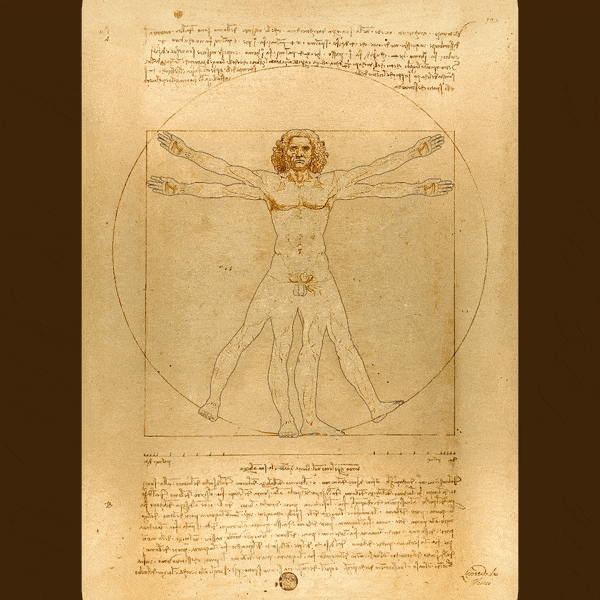
eastern astrology has a few interpretations but here's the one written by sanjay rath, based on traditional planets and organ systems:
sun: skeletal
moon: circulatory
mercury: nervous & integumentary
venus: reproductive
mars: muscular
jupiter: digestive
saturn: excretory

i disagree with both (eastern seems to fit my interpretation better though) as modern medicine has come a long way since then - while it may not be accurate for everything, as discoveries and advances will still and always will still be made, we can categorize some beliefs from the past as (generally) untrue.
i personally agree with putting signs as body part (if i say systems I'm talking about multiple body parts, rather than them working together) rulers and planets system rulers.
i'm starting with signs and then following with planets, as this seems like the more logical order. I can't list every body part, but it will be very detailed - comment/message and if i think it applies i will add it (cells/intracellular fluids do not have specific rulers).
aries/1st: skin, hair, nails, epithelial tissues
taurus/2nd: heart, veins/arteries
gemini/3rd: cerebellum, frontal lobe, occipital lobe, cns (including eyes)
cancer/4th: interstitial fluids (lymph, pus, spit, breast milk, etc.), eggs/sperm
leo/5th: blood (connective tissue)/intravascular fluid
virgo/6th: stomach hydrochloric acid, temporal lobe, parietal lobe, pns, ens
libra/7th: remaining connective (including osseous)
scorpio/8th: mesenchyme (connective) tissue, nephrons, cartilage, extracellular matrix
sagittarius/9th: enzymes, steroid/adrenal hormones*
capricorn/10th: joints, muscle tissues, protein (peptide/amine/glycoprotein) hormones
aquarius/11th: glands, lungs/airway, uterus, testes
pisces/12th: adipose tissues*
now for the slightly easier parts, planets in the modern order (why didn't i include rising? look in your first house - above in sign/degrees/house list with aries).
sun: fluid-based (lymphatic) immune**
moon: reproductive
mercury: nervous, digestive/excretory
venus: circulatory
mars: integumentary (exocrine)
jupiter: lipid structures/steroid-based endocrine*
saturn: musculoskeletal, protein-based endocrine*
uranus: respiratory
neptune: response-based immune* **
pluto: non-digestive excretory
*why are the jupiter signs not concrete? (aka i am preparied for the slander). jupiter and neptune are the 'expansive' and 'shadowy' planets (or as i like to say the 'overt/covert' planets) which means that unlike the other planets, there is not an easily decipherable concrete form (actually for the sake of technicality, there is a concrete form but its so large and made of so many parts that it is hard to see - think air molecules). jupiter being expansive is not the reason why it represents fats - jupiter's supportive nature (whether wanted or not) makes it the planet for fats. additionally, sagittarius which traditionally responds to gets tasks done quickly (whether correctly or not) represents every enzyme and steroid response. also saturn -> time -> growth.
**immune system is divided into: first the 'drainage' which is what the lymph picks up before being drained into lymph nodes, filtered and sent back to the bloodstream. 'but the sun is the outwards expression of personality' - hold on - the sun needs to 'take stock' of the other plants before expressing their desires in the 'sunny (lol) fashion' and it can only do this by passing through everyone else and collecting the inputs. the lymphatic network goes literally everywhere in the body and drains any 'extras' and doesn't make it waste - it eventually sends it back into the bloodstream. second the 'responses' - which is made of other parts of other systems working together. in the illusory nature of neptune (as described above) it makes sense to have the system that is not 'seen' but still works to defend from behind the scenes.

this is my theory but feel free to comment your questions and opinions if you have any - i'm interested in people's responses (and potential jupiter signs slander) - as I said, any input that I think applies may be added.
anyways,

~ Lala
40 notes
·
View notes
Text
I'm in wound care clinic today. For wounds with lots of tissue that's stuck to the wound, you can apply medihoney and then xeroform dressing on top.
For wounds with lots of drainage, apply Aquacel dressings and pt should elevated the area.
Vashe is a wound cleanser that can treat pseudomonas. One of the pts I saw today had a greenish looking wound, so the doctor asked the RN to put Vashe on the wounds. There's also Dakin's solution and Irrisept solution. You put the Vash on some gauze and soak it and let it stay on the wound for 15 minutes before dressing the wound.
Vashe - Vashe Wound Solution helps to cleanse the wound and accomplish the goals of wound bed preparation in a biocompatible, safe, effective, and natural way. This solution of hypochlorous acid (HOCl) acts as a preservative that inhibits microbial contamination within the solution. Vashe Wound Solution has the highest concentration of pure HOCl.
Dakin's solution - Dakin’s solution is a mixture of sodium hypochlorite (0.4% to 0.5%) and boric acid (4%) diluted in water. The boric acid (HȝBOȝ) acts as a buffering agent to maintain a pH of between 9 and 10, as alkalinity outside this range is found to be much more irritating. Boric Acid is also a mildly effective antiseptic. Irrisept - Irrisept is jet lavage containing low concentration Chlorhexidine Gluconate (CHG) 0.05% in sterile water for irrigation. CHG acts as a preservative to help inhibit microbial growth in the solution.
The mechanical action of the Irrisept system removes particulate and debris. The unique bottle design allows users to control the delivery pressure of the solution through manual bottle compression. Grasping the bottle firmly, the user can control the direction and pressure needed to help remove particulate and debris.
OptiLock is good for wounds with lots of drainage.
OptiLock - OptiLock is a super absorbent polymer core dressing. It takes in a remarkable amount of wound fluid — even under compression — and locks it away to help prevent maceration. Even more, this wound dressing is non-adhesive, meaning minimal disruption to the wound and gentle, pain-free removal.
OptiLock can be used as a primary dressing on partial-thickness and full-thickness wounds, such as: pressure, venous or neuropathic ulcers; post-operative wounds; superficial or partial-thickness burns (first- or second-degree); lacerations; abrasions. OptiLock can also be used as a secondary dressing on full-thickness wounds.
Santyl is another product that works for stuck on tissue. It has collagenase, which breaks down tissue that is stuck to a wound. With its unique mechanism of debridement, Collagenase SANTYL◊ Ointment has been shown to help wounds progress toward closure through byproducts that contribute to the migration and proliferation of fibroblasts, keratinocytes, and endothelial cells.
SANTYL Ointment uniquely and actively debrides by cleaving necrotic tissue at seven specific sites along the denatured collagen molecule, unlike endogenous debridement that only works at one site.5,7 While this effectively removes barriers to healing, it also aids wound progression by creating polypeptide bioactive byproducts8-11 that have been shown to signal cells associated with closure.
Epifix - EPIFIX is a dehydrated human amnion/chorion membrane allograft. EPIFIX is SMR2T Technology (Selective Membrane of Reparative and Reconstructive Tissue) which provides a semi-permeable protective barrier that supports the healing cascade. The product protects the wound bed to aid in the development of granulation tissue and provides a human biocompatible extracellular matrix that retains 300+ regulatory proteins.
Saw a pt who had a wound that was on the bottom of his foot. It was like a slit and there was a lot of callus around it because the pressure on his feet when he walks would hit that area of his foot. The doctor removed the callus tissue because that will help it heal. When wounds are dry, they won't heal. You can put Hydrogel into a wound so it can be more moist and it will heal better than a wound that is dry and not healing. You can cover it with a non-adhering dressing called Adaptic. Adaptic dressing is more confortable to remove. Hydrogel may also be more comfortable for pts.
7 notes
·
View notes
Text
Osmotic adaptation
✅ The mechanism of osmotic adaptation is employed to keep the intracellular fluid volume relatively constant despite changes in extracellular osmolality.
✅ In chronic hypernatremia for example, fluid tend to shift from intracellular compartment to extracellular compartment according to osmotic gradient, in response to this, cells increases their intracellular solutes such as betaine, inositol and glutamine, the difference in solute concentration between the two compartments reduces therefore fluid shifts will be limited.
✅ Conversely in chronic hyponatremia, fluid will tend to shift inside cells, therefore cells adapt by reducing their intracellular solutes inorder to counteract fluid shifts.
✅ The concept of osmotic adaptation is very important clinically, because osmotic adaptation needs time to be reversed after correction of the electrolyte disturbance, therefore rapid correction of electrolyte disturbance would have deleterious effects on cells, for example in chronic hypernatremia, cells already had built up a large concentration of intracellular solutes, if sodium concentration in the extracellular compartment is rapidly reduced to normal values, fluid will quickly shift to inside cells resulting in cell swelling, this manifests clinically as dangerous brain edema, hence correction should be slow according to well established guidelines.
#fluids#science#biology#college#education#school#student#medicine#doctors#health#healthcare#nursing#nurse#nursepractitioner
4 notes
·
View notes
Photo
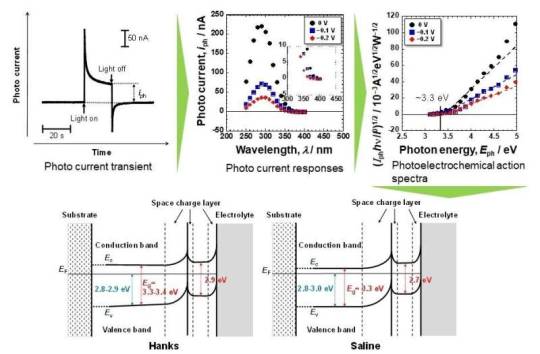
Exploring what gives titanium implants their remarkable biocompatibility
Scientists from the Tokyo Medical and Dental University (TMDU) used photoelectrochemical measurement and X-ray photoelectron spectroscopy to clarify the source of titanium's biocompatibility when implanted into the body, as with hip replacements and dental implants. They find that its reactivity with the correct ions in the extracellular fluid allows the body to recognize it. This work may lead to new generation medical implants that last longer.
Owing to its excellent strength and resistance to corrosion, titanium is commonly used in medical and dental implants. Over time, doctors have also noticed that patients with titanium implants generate less of an immune response than normally occurs when a foreign material is placed inside the body. This has been explained based on the biocompatibility of titanium. This biocompatibility may generate a problem, such as when screws made from titanium alloys assimilate too much into bone tissue after long-term implantation, which makes them difficult to remove later. Despite numerous studies on biological reactions with implanted materials, the reason for the biocompatibility of titanium remains poorly understood. A more complete explanation of the surface properties that give titanium these features is needed.
Read more.
27 notes
·
View notes
Text
Shamefully admitting that I can only remember that cytoplasm is kept rich in potassium (K) and poor in sodium (Na), while the opposite is true for extracellular fluid, because I think of little ions walking up to the cell membrane, asking to get in, and being told "Nah" (if sodium) or " 'K" (if potassium)
6 notes
·
View notes
Text
ProJoint Plus
ProJointPlus Review - ProJoint Plus Works? ProJointPlus Healthy Joints - ProJointPlus Reviews Projoint Plus is a blend of natural ingredients that has been formulated to aid in joint repair, support and flexibility. Containing 1500mg of Glucosamine, which helps maintain cartilage in healthy joints, and supports recovery from sports injuries. ProJoint Plus is a specialized blend of herbal extracts designed to support joint health. Some of the key ingredients in ProJointPlus include: Glucosamine Sulfate- A chemical compound, which occurs naturally in the body and is encapsulated in the fluid surrounding the joints. Quercetin- Natural ingredient, has useful antioxidant properties. MSM- Supports healthy joints Boswellia Extract - Of great interest to the natural health community. Containing 1500mg of Glucosamine Sulfate, ProJoint Plus can help keep your joints healthy. Another key ingredient in ProJoint Plus is Chondroitin Sulfate, which is naturally present in the extracellular matrix of skin, cartilage, ligaments, bones and tendons. Supplementing joint health is easy with ProJoint Plus. It is a supplement made with high quality ingredients and is trusted by satisfied customers around the world.As with any formula, it will depend on other factors and influences, such as your lifestyle and diet. And don't expect a miracle cure. ProJoint Plus supplement helps improve joint health, strong bones and mobility.
youtube
2 notes
·
View notes
Text
IV Fluid Types and Uses Nursing Therapy: (Isotonic, Hypertonic, Hypotonic)
IV fluids (also known as intravenous fluids) are special fluids administered to the intravascular compartment, which is part of the extracellular compartment space. Intravenous fluids are an extremely common treatment ordered for patients in the hospital setting.
Nurses administer IV fluids per the healthcare provider orders to help treat fluid volume deficits via dehydration, electrolyte…
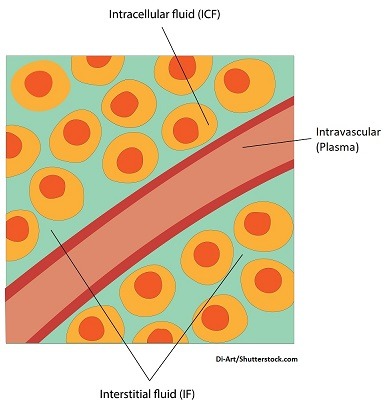
View On WordPress
3 notes
·
View notes
Text
The list of lab equipment needed for the psychology lab.
1. Computers and software for data analysis and experiment design
2. Psychophysiological equipment such as EEG, ECG, and GSR sensors
3. Eye-tracking equipment for measuring eye movements
4. Stereotaxic instrument for precise animal brain surgery
5. Skinner boxes for operant conditioning experiments
6. Virtual Reality headsets for immersive experience and behavioral testing
7. TMS (Transcranial Magnetic Stimulation) for non-invasive brain stimulation
8. Magnetic resonance imaging (MRI) or functional magnetic resonance imaging (fMRI) for brain imaging
9. Polygraph machines for lie detection
10. Sound-proof rooms for auditory experiments
11. Video recording equipment for observational research
12. Reaction time devices to measure response times
13. Stimulus presentation software and hardware, including monitors and speakers
14. Questionnaires and survey tools for self-report research.
15. Digital voice recorders for recording interviews or focus groups
16. Psychometric tests for assessing cognitive or personality traits
17. Tactile equipment for haptic experiments
18. Olfactometers for investigating sense of smell
19. Weight scales and height measurements for anthropometric assessments
20. Blood pressure monitors for physiological measurements
21. Heat/cold pain stimulation devices for pain threshold experiments
22. Sleep monitoring equipment such as actigraphy watches and polysomnography machines
23. Specialized software for analyzing and visualizing data, such as SPSS or R
Climatic chambers for environmental manipulation in behavioral studies
24. Microscopes for examining cellular and tissue samples in behavioral neuroscience research
25. Mobile EEG devices for field research or studying participants in naturalistic environments
26. Functional Near-Infrared Spectroscopy (fNIRS) for measuring brain activity in real-time
27. Motion capture systems for tracking movement and gestures in experiments or simulations
28. Biometric devices such as heart rate monitors, respiration sensors, or skin temperature sensors for physiological measurements
29. Experiment control software for designing, running, and analyzing experiments
30. Virtual assistants or chatbots for social psychology or human-computer interaction research
31. Social robots for studying human-robot interaction and social cognition
32. Biomarker assay kits for measuring stress hormones, neurotransmitters, or immune markers
33. Magnetic bead separation systems for isolating cells or proteins from biological samples
34. Chemical analysis equipment such as gas chromatography or mass spectrometry for analyzing biological fluids or tissues.
35. Eye-safe lasers and retinal imaging systems for visual neuroscience studies
36. Microdialysis probes for measuring extracellular neurotransmitter levels in vivo
37. Microfabrication and microfluidics equipment for designing and building micro-scale devices for neuroscience or behavioral studies
38. Magnetic resonance spectroscopy (MRS) for analyzing brain chemistry
39. Automated behavioral testing systems for high-throughput phenotyping of animal models
40. High-speed cameras for studying rapid movements or reactions in experiments
41. Autonomic monitoring systems for measuring heart rate variability and other physiological signals
42. Neurofeedback systems for training participants to regulate their brain activity
Infrared thermal imaging for measuring temperature changes on the skin or body surface
43. Environmental monitoring equipment for measuring air quality, temperature, humidity, or lighting in experimental settings.
44. Animal behavior tracking systems for automated behavioral analysis of animal models
45. Optogenetics equipment for genetically modifying neurons and controlling their activity with light
46. Microscopy equipment such as confocal microscopes or two-photon microscopes for imaging neurons or brain tissue
47. High-density EEG or MEG systems for recording brain activity with high spatial and temporal resolution
48. Ultrafast laser systems for optoacoustic or photothermal imaging of the brain or other tissues
49. Microscale thermometry systems for measuring temperature changes at the cellular level
50. Animal housing and care equipment such as cages, bedding, and feeding systems
51. Laboratory safety equipment such as fume hoods, eye protection, and fire suppression systems
52. High-performance computing resources for large-scale data analysis, simulations, or modeling.
The specific equipment needs of a psychology lab will depend on the research questions and methods being used, as well as the available resources and funding.
It's also important to note that some of the equipment listed here may require specialized training or certification to use safely and effectively.

1 note
·
View note
Text
Pts with EtOH use disorder often have low phosphate because they don't eat. They also have low vitamin D intake-> secondary hyperparathyroidism-> high urinary phosphate excretion. Their serum phosphate may appear normal due to extracellular shift of phosphate. When you feed them or give IV fluids with glucose, insulin causes phosphate to shift intracellularly, so their phosphate level decreases. Respiratory alkalosis also shifts phosphate into cells. Rhabdomyolysis can occur from hypophosphatemia. Check CPK level. Pts with EtOH use disorder often have myopathy, so hypophosphatemia + myopathy-> symptomatic rhabdomyolysis.
2 notes
·
View notes
Text

Sensory Forces
Organoids (lab-grown tissue models) grown on hydrogel with tuneable mechanical properties reveal the role of the extracellular matrix forces in guiding the formation of sensory epithelium – such as that involved in hearing in the inner ear
Read the published research paper here
Image from work by Mingyu Xia, Mingxuan Wu, Yuanrong Li and colleagues
State Key Laboratory of Fluid Power & Mechatronic Systems, Zhejiang University, Hangzhou and State Key Laboratory of Medical Neurobiology & MOE Frontiers Center for Brain Science, Fudan University, Shanghai, China
Image originally published with a Creative Commons Attribution 4.0 International (CC BY 4.0)
Published in Science Advances, November 2023
You can also follow BPoD on Instagram, Twitter and Facebook
#science#biomedicine#immunofluorescence#biology#organoids#sensory epithelium#epithelia#epithelium#extracellular matrix#neuroscience
8 notes
·
View notes
Text
Internal Structure of a Neuron
The Four Main Families of Organic Chemicals in the Brain
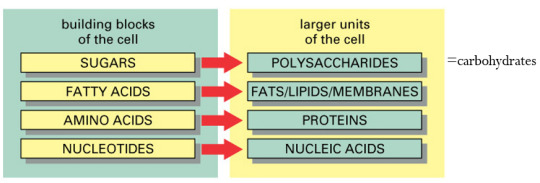

Inside a Neuron

Major Neuronal Organelles
- Cell membrane
- Mitochondria
- Nucleus
- Endoplasmic reticulum
- Golgi apparatus
- Cytoplasm: all the fluid inside the neuron (intracellular fluid) including the fluid inside the cell body (soma), inside the dendrites, and inside the axon & axon terminal (called axoplasm).
- Neurofilaments and microtubules are both found in the cell body, dendrites, and axon. Both help the neuron maintain its structure (like a skeleton).
- Lysosomes are cellular organelles that contain acid enzymes to break up waste materials and cellular debris.
- Enzyme = biomolecule responsible for breaking down chemicals
Cell Membrane
- The plasma membrane forms the outer “wall” of each neuron (including the cell body, dendrites, axon, axon terminals).
- Separates intracellular and extracellular fluid
- Regulates movement of substances into and out of the cell: most cannot pass
- Structure:
lipid bilayer (fat molecules) + proteins embedded in membrane
Proteins form receptors that bind different chemicals, including drugs.
Proteins form ion channels, allowing ions in and out of cells, creating electrical currents.
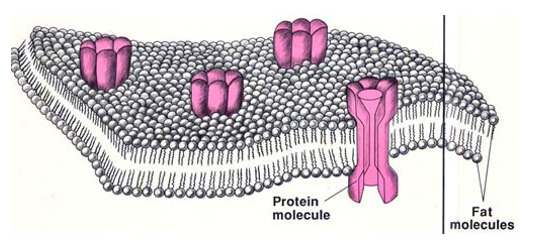
Mitochondria
- singular: mitochondrion
- look like kidney beans
- “Powerhouse of the cell”
- breaks down nutrients such as glucose to provide cell with energy (adenosine triphosphate, ATP) so it can function
- Many mitochondria scattered throughout the neuron’s cell body, also in its dendrites, axon, and axon terminals.
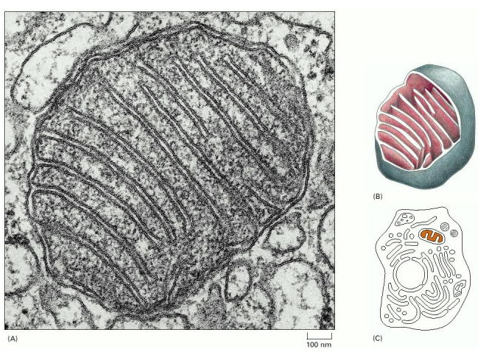
Nucleus
- surrounded by nuclear membrane (formed by two lipid bilayer membranes)
- contains genetic information: chromosomes (genes). Each chromosome consists of a single, long DNA molecule associated with proteins.
- Genes: segments of DNA that encode the synthesis of particular proteins.

Endoplasmic Reticulum
- formed from the lipid bilayer membrane that extends from the nucleus
- Ribosomes: protein structures that act as catalysts for protein synthesis
- Responsible for assembling proteins via method called translation:
later phase of protein synthesis in which the mRNA travels from nucleus to the ER. mRNA is translated into a particular sequence of amino acids to form a protein.

Information Flow Contained in Genetic Code
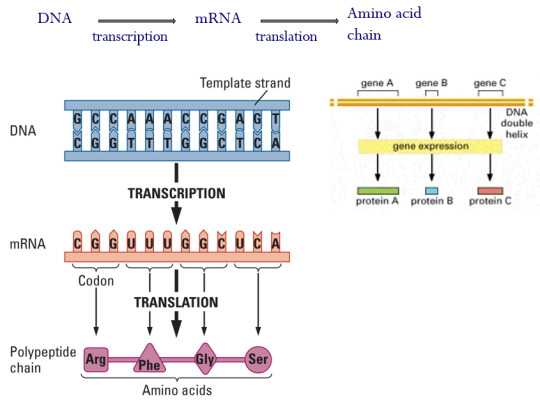
Golgi Apparatus
- a collection of several lipid bilayer membrane-enclosed cisternae (4-6) connected to each other and also to the EPR
- a major site of carbohydrate synthesis
- a sorting and dispatching station for the products of the EPR (proteins)
Nucleus, endoplasmic reticulum, and Golgi apparatus work together to synthesize and distribute proteins.
Proteins made at the EPR travel on to the Golgi apparatus where they are labeled by carbohydrates and wrapped inside bags called vesicles. The lipid bags protect the proteins inside from being degraded (broken down) by enzymes within the cell.

Protein Transport

Synapse
Neurotransmitters released from the presynaptic site bind to receptors on the postsynaptic site.


3 notes
·
View notes